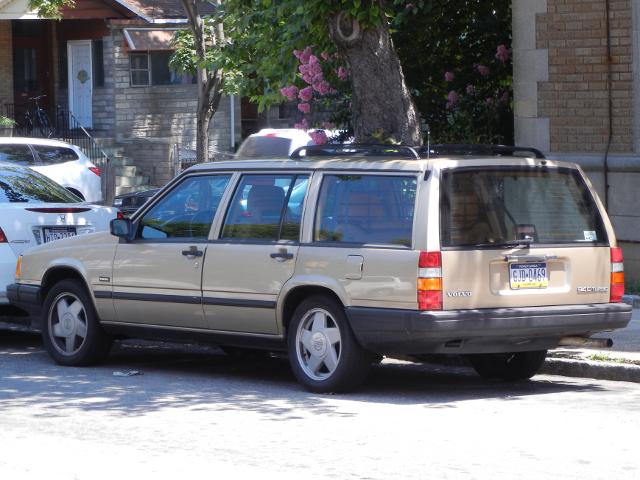Beige Volvo Station Wagon 940 Turbo in album cars
In Albums: Philadelphia cars

Jul 10th, 2011, by Alex Zorach
This photo shows a beige Volvo Station Wagon 940 Turbo, parked on a street in West Philadelphia. Seeing this car brought back fond memories of my old car, a 1985 Volvo Station Wagon DL of a similar color. This is an old car and yet it looks in great shape; a testimony to the fact that these older Volvos were well-built and worth maintaining.
I have both driven and ridden as a passenger in a number of Volvos, both station wagons and sedans. I have not driven this particular model but I have driven one just a hair older and one just a hair newer. This time period, in my opinion, captures what I see as the decline of the quality of Volvo cars. Volvo shifted from being one of the best automobile manufacturers to one whose cars I would not consider buying.
The turbo option highlights one of the key things that I saw as being wrong with the approach Volvo took. Volvo tried to become something that it was not good at, and something that its loyal customer base was not interested in. People who want a fast car similar to Volvo would buy a Saab, a brand that had a long track record of cars with a faster and more sporty feel to them. I have driven a newer Volvo with turbo, and a number of models, new and old, without. On some level, I can understand why someone would want a turbo option on these cars. Volvos tend to be very heavy cars, and the older ones had V4 engines which were not quite powerful enough to speedily propel the cars up hills. However, the turbo option results in a rather touchy acceleration. The fuel efficiency is also quite miserable on the Volvos with turbo that I've owned. Whereas my old stationwagon could get 29 mpg highway even as it approached 20 years of age, the Volvos with turbo tend to get only around 22, and sometimes less in the city--embarrassingly low mileage for a car of this size. In a sense, Volvo was going for quick bucks, rather than being committed to sustainability.
If you want a sexy sportscar, you don't buy one of these boxy Volvos. Volvos are an eminently unsexy car, and that's precisely what makes them so lovable. The Volvo brand was built on safety and security. And I hate to say it, but I personally love the boxy look, and the sluggish but easy-to-control handling of the earlier Volvos. They drive like tanks, but they handle very smoothly, especially at low speeds, and are exceptionally easy to parallel park given their large size.
Another aspect of Volvo cars that was declining was visibility. The slightly newer models, such as the Volvo 850 Station Wagon (which was parked across the street from this one, incidentally), have much bulkier supports all around, and accordingly, have much poorer visibility. It's hard for me to tell what the visibility would be like in this car, without actually driving it, but just looking at the size of the supports, I suspect this car has better visibility than the 850 but not as good as the older DL series that I used to drive. As Volvo gave up smooth handling, maneuverability in tight city conditions, visibility, and fuel efficiency, they permanently lost me as an owner who would have been very loyal to the brand had they simply stayed the same.